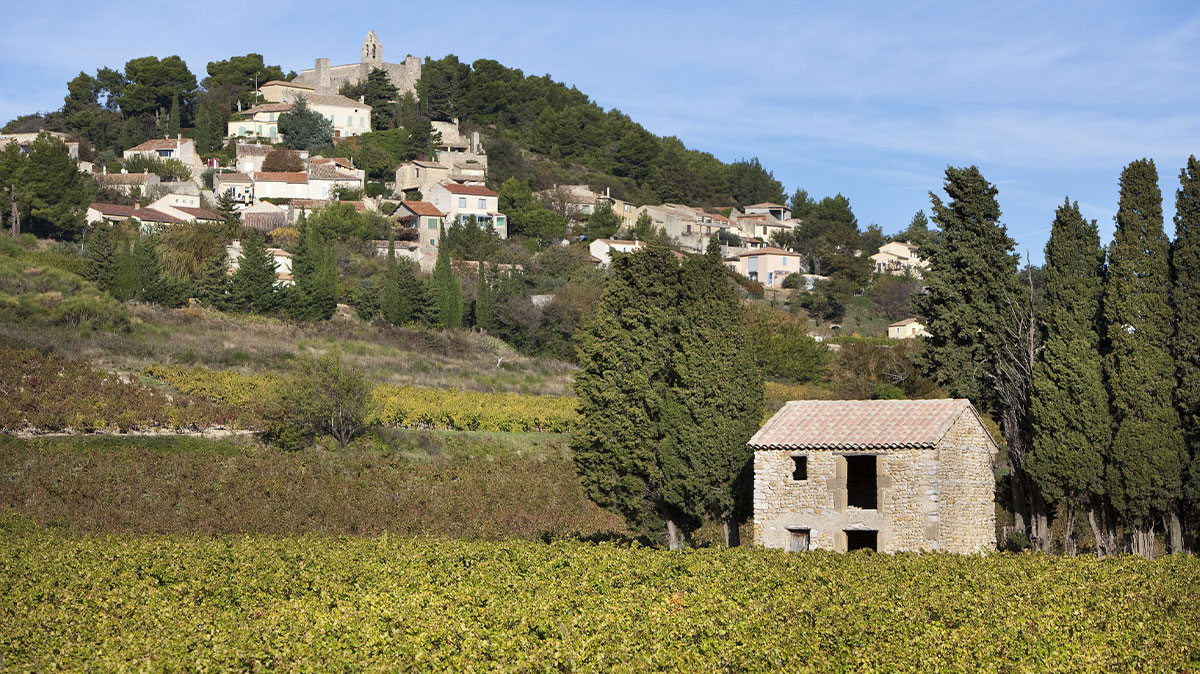France’s third largest appellation (behind Languedoc-Roussillon and Bordeaux), the Cotes du often seems like a forgotten middle child as wine lovers argue about their preference for either Burgundy or Bordeaux. While the former is the home of Pinot Noir and Chardonnay and the latter is known for red blends based on Cabernet Sauvignon or Merlot and whites featuring Sauvignon Blanc and Sémillon, the is home to 37 grape varieties of which only a few are household names. While a handful of its AOCs (appellation of controlled origin) offer wines made with 100 percent single-varietal wines, the Rhône has truly made its reputation on the art of the blend, to the point that reds using varieties such as , , and Mourvèdre are known worldwide as Rhône-style blends and the same goes for whites based on Marsanne and Roussanne regardless of where they are grown.
As with other European denominations, Rhône Valley wines are referred to by appellation rather than grape, so you will likely see them listed under names such as Côtes du Rhône, Châteauneuf-du-Pape, Hermitage, or Condrieu rather than by name of the grape. The good news for savvy wine lovers is that while Pinot Noir and Cabernet Sauvignon command sky-high prices on tables and shelves, the Rhône Valley varieties’ insider secret status often makes them much more accessible than bottles from elsewhere in France.
History of the Rhône Valley
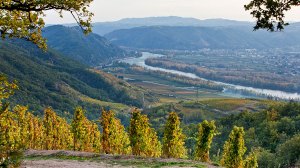
Inter Rhône
Home to wine grapes on its steep riverside slopes since the time of the Greeks and Romans, the Rhône Valley was a center of amphora production for storage and transport of wine by the first century AD, a period that also saw construction of stone retaining walls and terraced vineyards. The collapse of the Roman Empire saw the end of the region’s importance in the wider Mediterranean basin, and although viticulture continued up and down the river it took the relocation of the seat of the Catholic church from Rome to Avignon in the early 14th century to give rise to extensive grapevine planting in and around the southern part of the valley. In the late 17th century, the port of Roquemaure, eight miles north of Avignon, became a prominent center for shipping goods by river. The area was by then well known for its wine, and the tops of barrels sent by boat bore the initals CDR for coste du Rhône, an early sign of its provenance. Some of the first rules of what has become the French AOC system began here; in 1936, Châteauneuf-du-Pape was designated as the first AOC in the country, and the overarching Cotes du Rhône achieved that status a year later.
Climate and Geography of the Rhône Valley
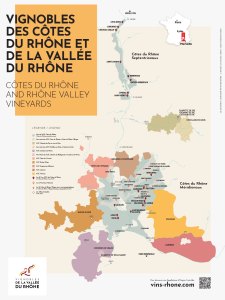
Running 150 miles from north to south along steep riverbanks, the Rhône Valley is home to just shy of 160,000 acres of grapevines in 148 communes. The valley’s stunning landscape is the result of epic geological phenomena that occurred 300 million years ago. Volcanic eruptions in the Massif Central gave birth to the granite rocks of the northern Rhône, while layers upon layers of calcareous marine deposits in the south gave rise to prominent sandstone formations. Between 24 and seven million years ago, shifting tectonic plates caused to alps to rise up and caused the collapse of the valley floor, allowing water from the Mediterranean to enter. As this eventually receded, it left behind the base layer of limestone, clay, sand, and granite that exists to this day.
The northern portion of the valley has a continental cold and windy winter and a hot Mediterranean summer, while the south experiences a more moderate Mediterranean climate year-round. While 32 different winds—each with a name—are noted for bringing in varied weather conditions, the most notorious is the Mistral. Sometimes blowing with such intense force that it knocks ancient trees to the ground, it also moves moisture and clouds out of its path and is responsible for hot, sunny days and cool nights that are tempered by heat-retaining rocks and stony vineyard soils.
The Rhône is divided into two distinct regions, the Northern Rhône and Southern Rhône, which are further subdivided into village appellations which each have their own production regulations. The basic quality level is Côtes du Rhône, which accounts for 60 percent of the output from the region. The most notable wines from the north, all Syrah-dominant, are Hermitage, Crozes-Hermitage, Cornas, Cote-Rotie, and Saint Joseph. The most prominent Southern Rhône appellations, producing Grenache-heavy blends, are Châteauneuf-du-Pape and Gigondas. While white wines are only about 12 percent of total production, a wide range of white Côtes du Rhône wines are available in the market as well as bottles of white from the Condrieu, Hermitage, Crozes-Hermitage, Saint-Péray, and Saint Joseph appellations in the north and Côtes du Rhône Villages, Châteauneuf-du-Pape, Lirac, and Vacqueyras to the south. There is also one sweet wine AOC, Muscat de Beaumes de Venise, which is a favorite with crème brulée or foie gras in many a restaurant.
Key Grapes of the Rhône Valley
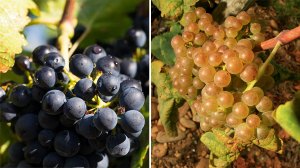
Inter Rhône
Among the 37 grape varieties cultivated here, 88 percent are red and 12 percent are white; a portion of the red grapes go into rosé wines that account for about 14 percent of total production. The two main red grapes here are Syrah and Grenache, with Syrah the predominant variety in the north and Grenache holding first place in the south, where it is also blended with other grapes including Mourvèdre, Carignan, and Cinsault. While most of these have grown here and across the border in Spain for hundreds of years, a more recent addition is Marselan, a cross between Grenache and Cabernet Sauvignon that was first bred in 1961. The key white varieties in the Northern Rhône are Marsanne and Viognier; the Southern Rhône offers more diversity with options that include those two plus Grenache Blanc, Clairette, and Roussanne. The 13 varieties traditionally permitted in Châteauneuf-du-Pape are Grenache, Mourvèdre, Syrah, Counoise, Terret Noir, Vaccarèse, Muscardin, Clairette, Picpoul, Picardin, Bourboulenc, Roussanne, and Cinsault. Wine scholars among us will recognize this as a mix of red and white grapes, with white allowed only in very small amounts.
The Rhône Valley’s Top Winemakers
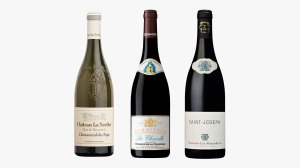
Over 6,000 vineyards grow grapes for about 1,800 private wineries and 103 cooperatives, so there is a huge range of producers to choose from. Widely considered one of the finest Syrahs in the world, Domaine de la Chapelle La Chapelle Hermitage hails from a steep hillside that has been planted with the variety for 800 years. For 16 generations the Chave family has been making wine in the Northern Rhône, and Jean-Louis Chave, who took over in 1993, is consistently producing bottles loved by oenophones. The granitic, pebble-strewn soils that are the home of Domaine Les Alexandrins Saint Joseph Les Ponts is another coveted spot for ideal cultivation of Syrah. At the northern edge of the appellation, Château de Beaucastel has been organically farming all 13 permitted varieties for its benchmark Châteauneuf-du-Pape since the 1960s. Domaine du Colombier Cuvée Gaby Crozes-Hermitage, another gorgeous Syrah, is named for proprietors David and Florent Viale’s father Gaby; grapes are cultivated in a plot planted by their grandfather more than 50 years ago. Made with 100 percent Clairette, Chateau de Saint Cosme Le Poste Gigondas Blanc is a testament to the Barruol family’s expertise across the appellation. Château La Nerthe Clos de Beauvenir Châteauneuf-du-Pape Blanc, a single-vineyard cuvée of Rousanne and Grenache Blanc, is an outstanding example of the white wines from an AOC much better known for its reds.
Best Vintages from the Rhône Valley
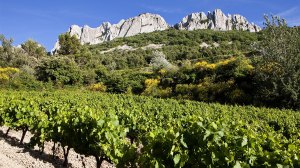
RR_Rhone_Valley_Explainer_2
Inter Rhône
Despite an erratic growing season that saw a cool spring, intermittent summer hail in some areas, and soaring temperatures in August, 2023 turned out to be a good vintage for reds and an excellent vintage for whites. Whereas 2022’s weather had an opposite effect; an extremely dry, hot summer that in some parts was saved by mid-August rain yielded better results for red wines than white, but stick with the best producers in either case. Despite a relatively hot and dry summer and an early harvest, the 2020 vintage is noted for excellent freshness and acidity across the board thanks to cooler than average nights and an absence of prolonged heat spikes. The 2019 vintage is heralded for equally high quality among white and red wines noted for complexity and acidity. Those looking for both mature whites that are ready to drink and fully drinkable reds that could also stand more cellaring should seek out bottles from 2015, which at the time was considered the best vintage of the century so far.
Fun Facts About the Rhône Valley

Arterra/Universal Images Group/Getty Images
- Côtes du Rhône was originally called the singular Côste du Rhône because wines only came from the right bank of the river, not both.
- Since 1954, the village of Châteauneuf-du-Pape has had a law forbidding flying saucers from landing in, taking off, or flying over its vineyards.
- Condrieu and its wholly contained single-vineyard AOC Château-Grillet are the world’s only appellations whose wines are 100 percent Viognier.
The papacy moved from Rome to Avignon in 1309 and remained there until 1377 due to political unrest in Rome, giving rise to the term Châteauneuf-du-Pape, which means the Pope’s new castle.
Authors
-
Mike DeSimone and Jeff Jenssen
Mike DeSimone and Jeff Jenssen, also known as the World Wine Guys, are wine, spirits, food, and travel writers, educators, and hosts. They have been featured guests on the Today Show, The Martha…
Credit: robbreport.com

